Digital is everywhere. Like it or not, it’s shaping the audio landscape. The original iPod introduced digital audio to the masses and marked the advent of a full-blown digital lifestyle. As technology has advanced, we’ve seen the development of an entirely new breed of products: wireless speaker systems.
Features Overview
With the Crescendo ($899.95 MSRP), MartinLogan certainly didn’t hold back any punches. If you’re going to make a lifestyle statement, then the Crescendo is the way to do it. As I wrote in my initial unboxing preview article, the MartinLogan Crescendo is one of the sleekest and sexiest pieces of audio I’ve ever had in my system.
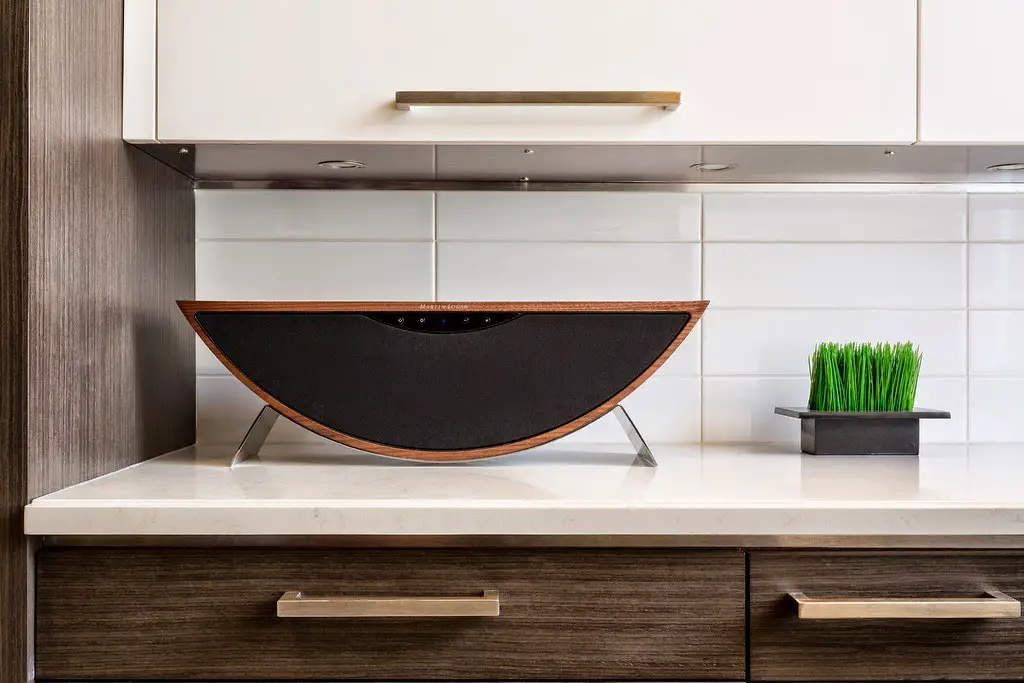 |
| The Crescendo’s aesthetics were a huge home run with women of all ages. |
I’ve never before received universal compliments for a piece of audio equipment before from so many women across multiple generations. That’s right guys, women. From millennials to the greatest generation, the aesthetics of the Crescendo are a huge home run. Gentlemen, the Crescendo just may be your secret weapon to winning the WAF factor war for audiophile gear. Oh, and in case you’re wondering, the Crescendo isn’t just another pretty face. This baby is built for performance.
Connectivity options abound. The Crescendo features just about every wireless and physical connection option you can think of including WiFi (802.11 b/g/n), Ethernet, USB, and a 3.5mm mini Toslink optical/analog input. Protocols supported include Apple AirPlay, DLNA, and Bluetooth v. 4.0 (with apt-x). There’s even a subwoofer output. Connectivity options have been thoroughly thought out. If you wanted to really nitpick, then the only inputs arguably missing are HDMI and coax digital.
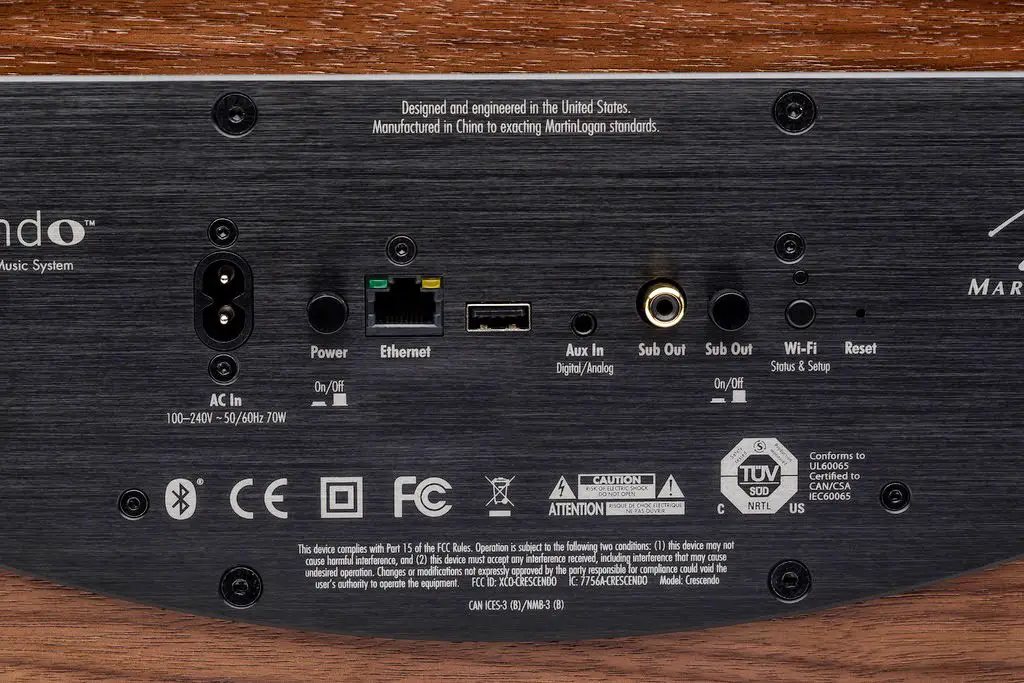 |
| The Crescendo has just about every kind of input connectivity option you would want and the included subwoofer output is a huge bonus. |
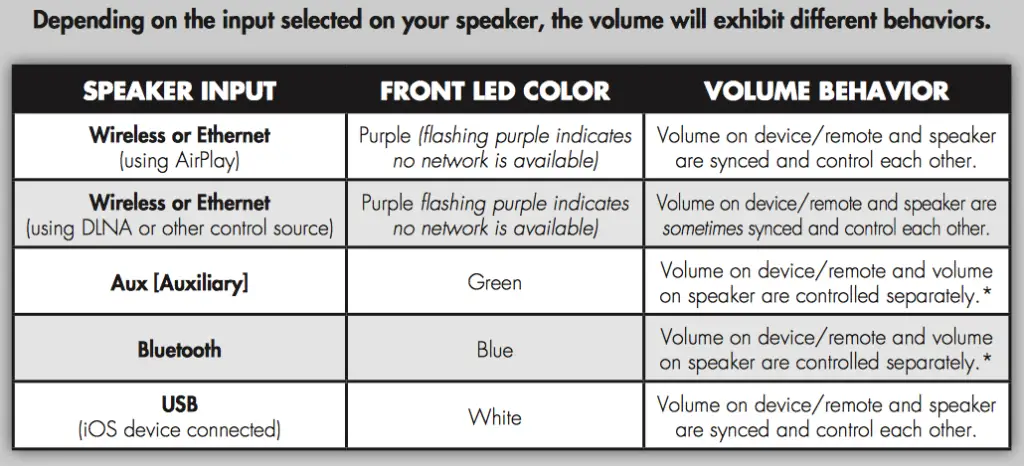 |
| The Crescendo’s user manual does an excellent job explaining the behavior of each input. By using AirPlay and Bluetooth, I never had to pickup the included remote for any functionality. |
The Crescendo is fully Apple AirPlay compliant and its integration with Apple devices is simply brilliant. The Crescendo lacks any on-screen display. However, if you’re an Apple mobile user, there’s an ingeniously easy way for you to join the Crescendo to your WiFi network using a feature called WiFi copy.
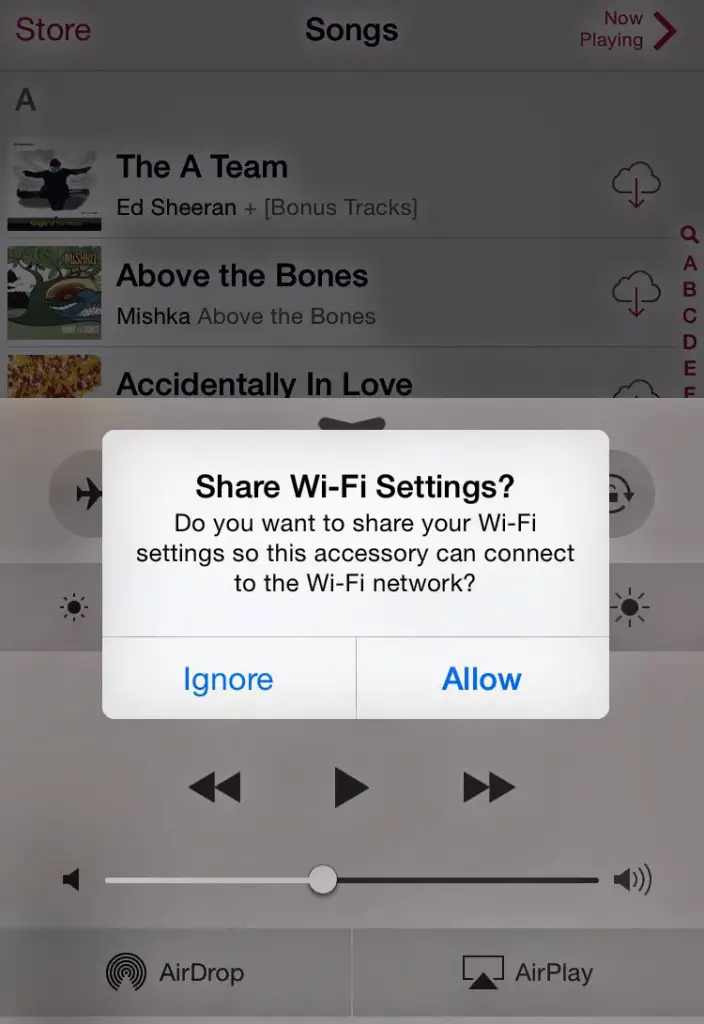 |
| With Apple’s WiFi copy feature, you can share your WiFi settings from your iPhone or iPad directly to the Crescendo. Simply plug in your iPhone or iPad to the Crescendo, hit “Allow” and you’re done. |
To use WiFi copy, simply plug your Apple iPhone or iPad into the Crescendo’s USB port and you’ll be prompted to copy your WiFi configuration from your iPhone/iPad to the Crescendo. The process takes about 10 seconds. It’s flawless.
I wish all wireless devices were this simple to setup. WiFi copy, in case you’re wondering, is Apple-specific. If you’re a non-Apple user, you can still use your laptop or Android mobile device to log into the Crescendo’s built in web server and configure the unit manually. Though not as elegant, it still works.
Under the hood, there is a 24-bit 48kHz DSP-based preamplifier section that mates with a Class D closed loop 100 watt amplifier. The Crescendo’s amplification is divided among the different drivers. 25W goes to each of the .94” x 1” Folded Motion tweeters for a total of 50W. The remaining 50W goes to the 5” x 7” fiber cone with extended throw drive assembly.
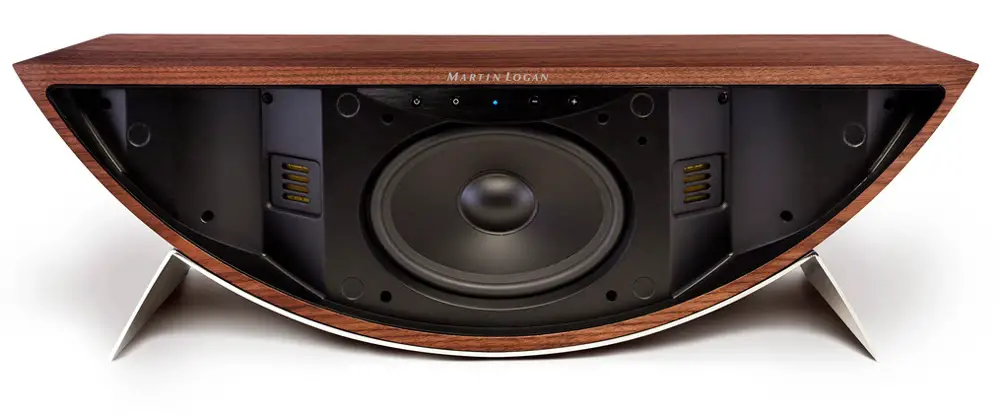 |
| Detail of the Crescendo without its magnetic grille. The dual Folded Motion tweeters are angled to improve stereo separation and provide a 160 degree listening window. |
The drivers are covered by a magnetic front grille. Pressing on the upper two sides of the grille will cause it to instantly pop off. To put it back on, just hold the grille close to the unit and its strong magnets will instantly snap it seamlessly back into place. I always applaud manufacturers that provide magnetic grilles as an option. MartinLogan’s implementation is especially well-done with wonderfully strong magnets.
There are two color options for the Crescendo: natural walnut veneer and high gloss piano black. My review sample was finished in natural walnut veneer. The veneer is good quality. It’s polished to a matte finish without any visible seams and will fit into any decor nicely.
Design and Aesthetics
Ordinarily, I’d gloss over a product’s aesthetics. Let’s face it, you don’t normally think of speakers as prime examples of aesthetics. However, in the case of the Crescendo, it deserves special attention.
Given the positive reaction of so many women to the Crescendo, I asked the team at MartinLogan about the unit’s design. They told me that they focused on the physical design after the acoustic platform had been completed. In other words, they wrapped the design around the size restraints the engineers provided.
According to MartinLogan, they wanted something that would stand out from typical square box designs and was as iconic as the their electrostatic speakers. To accomplish this, they took a lot of design cues from other products to make the Crescendo feel like a natural extension of the MartinLogan brand. For example, the arching based is a reminder of the curve found in an electrostatic panel. The real-wood veneers, polished aluminum, and a dense MDF enclosure all can be found on many of MartinLogan’s other loudspeakers.
The folks at MartinLogan were quick to emphasize that the Crescendo’s premium materials are not typically found on wireless streaming systems. MartinLogan told me that they labored for months over the final details such as the variation of walnut that would be most acceptable to their customers down to where to put the buttons to control Crescendo. Based on the real-world feedback I got, MartinLogan’s design is a winner.
The relatively compact form-factor of the Crescendo posed some engineering challenges that needed creative solutions. For example, MartinLogan wanted to make the widest sound stage possible. However, without the tweeters having good physical separation, the illusion of stereo sound falters. MartinLogan’s engineers tested many different configurations, and ended up angling the Folded Motion tweeters out to further enhance stereo separation for an expansive image from the single speaker design. The Crescendo’s soundstage is supposed to give you a roughly 160 degree listening arc.
The Crescendo is a dual-ported design. The dual-ports on the underside of the unit are a combination of both form and function. The MartinLogan team told me that placing ports on the underside allowed for a more consistent environment for the ports to interact with since the Crescendo will always be placed on a table or shelf of some sort. Second, they just needed the space on the back for electronics and connections.
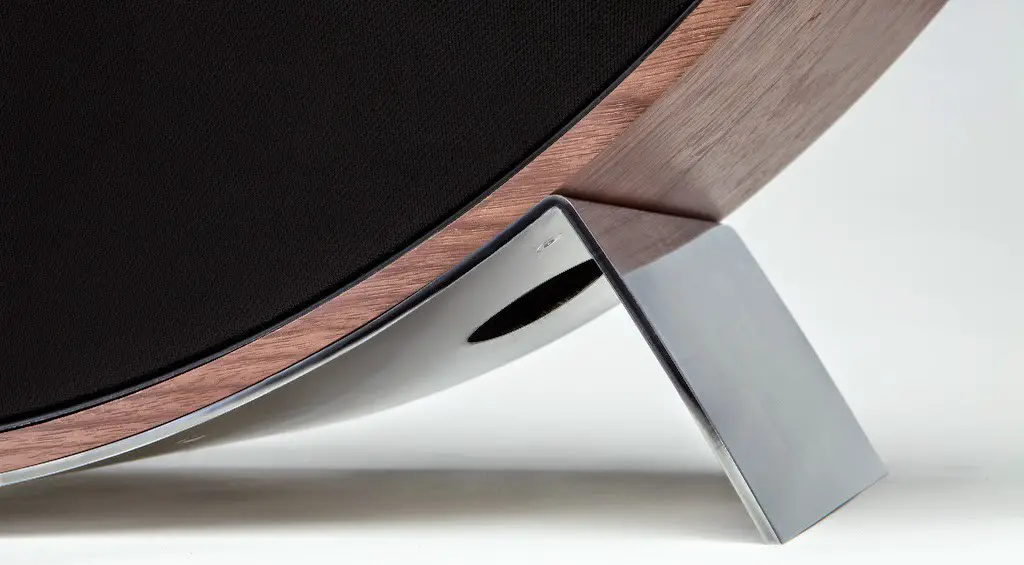 |
| The Crescendo is a dual-ported design. The speaker’s ports are inconspicuous and hidden on the underside of the unit. |
The Crescendo and Home Theater
As I was surveying the connectivity options on the Crescendo, something struck me as odd. The Crescendo had a subwoofer output port. A subwoofer output port isn’t typical on stand-alone speaker systems.
On the one hand, this made sense. The Crescendo only goes down to 50Hz. Some competitors’ all-in-one streaming models go deeper; but their bass isn’t necessarily accurate. Thus, if you really wanted the full impact of your music, then a complimentary sub could fill things out perfectly. But something else also struck me. The Crescendo could also serve as a high end sound bar for home theater.
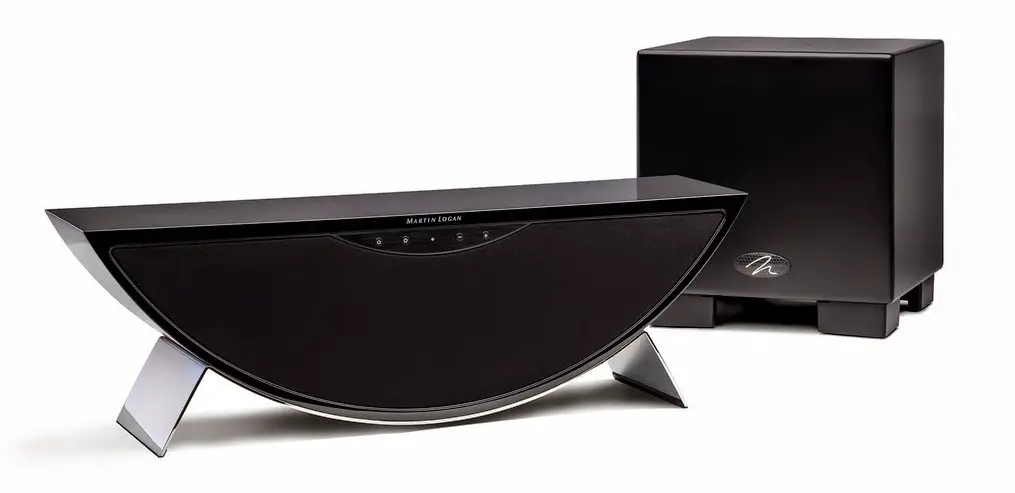 |
| The Crescendo is designed to work seamlessly with an external sub like MartinLogan’s own Dynamo models. Adding a sub gives you superb home theater performance. |
This thought then got me thinking about audio decoding and what would happen with multichannel tracks. MartinLogan confirmed that the Crescendo was indeed designed with this in mind. However, there’s no multichannel decoder built into the preamp section. If you wanted to use the Crescendo for this home theater style application, you’d need to down-mix a multichannel signal to stereo, which is easily done within your Blu-ray player.
In case you’re wondering, the Crescendo takes care of all the subwoofer crossover settings. It has a fixed, internal crossover of 70Hz. Mating a subwoofer with speakers can get overly complicated. Thankfully, MartinLogan makes it easy. In the manual, they give you the volume settings to use for their own Dynamo subwoofer models. If you’re using a non-MartinLogan sub, all you need to do is set your sub’s high pass and low pass filter to their highest settings. Then, adjust the volume to what sounds natural. If you’re sub has a phase adjustment, turn it to the setting that sounds best. Bingo, you’re done.
Thinking about all these potential options got me really excited about the Crescendo’s potential us in a variety of environments.
Setup
Setting up the Crescendo was straightforward. I plugged in my iPhone and in a matter of seconds, a prompt appeared on my iPhone to copy my WiFi settings. I pressed OK and voila I was done. I’ve never ever had a simpler way to setup a unit—brilliant.
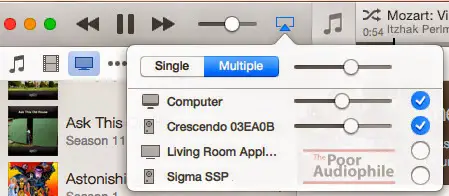 |
| The MartinLogan Crescendo appears as an AirPlay speaker from within iTunes. You can adjust the Crescendo’s output volume independently of other speakers. |
Next, I turned to Bluetooth. In case you’re wondering, I asked MartinLogan if there’s a limit to the number of Bluetooth devices you can pair. Their response was that there’s no limit.
To further complicate this, you don’t get a clear error message telling you that this is the problem. I related this scenario to the MartinLogan team and they replied that this is a limitation of the Bluetooth protocol’s implementation. So, if you have multiple devices connected to the Crescendo via Bluetooth, you need to be aware of this issue. It can be a real pain and hopefully this explanation will save someone a lot of troubleshooting and frustration. In case you’re wondering, AirPlay doesn’t have the same silly limitation.
Another issue crept up during my initial setup: speaker hiss. When I first turned on the Crescendo it was dead silent. However, after connecting a source—it didn’t matter what kind—the Crescendo would emanate a hissing during silent passages and even during standby mode. I was able to replicate this pattern. Unplugging the unit and re-plugging it back in would fix the hissing issue until I started playing audio and then it would start again.
Listening Tests
As you can glean from above, I spent an extensive amount of time getting to know the Crescendo inside and out. In fact, with all the back and forth with MartinLogan, I had the unit for almost four months—including the Christmas and New Year holidays. For perspective, that’s at least four times longer than the average reviewer would have with a review unit.
During that time, I used the Crescendo in at least four different venues: my office, my living room, my bedroom, and my parent’s house. I also positioned the Crescendo against a wall, in the middle of a room, and on a bureau about 10 inches from the wall. I mention all this because the sound was incredibly consistent regardless of where I placed the unit. In particular, the Crescendo’s bass didn’t change based on it’s proximity to a boundary, such as a wall. That down-firing, dual-ported design worked nicely.
Throughout my listening period, I found the Crescendo to be an solid, able, and stable performer. I used AirPlay and Bluetooth almost exclusively throughout the review period with AirPlay comprising about 90% of my usage. There were no lags, drops or other anomalies with my wireless streaming experience and the audio quality was excellent. Let me highlight a few examples.
One evening, my brother-in-law asked if he could play Lucinda Williams’ classic album Car Wheels on a Gravel Road on the Crescendo. Lucinda Williams has one of those distinctive voices. You’ll know right away if you’ve nailed her vocals or missed the mark. My audiophile brother-in-law was taken aback when he heard this album streamed via Bluetooth. “Wow. Her vocals are pretty much spot-on,” he remarked. I agreed. Instruments had a nice, natural timbre without any exaggeration. The sound was spacious—even off-axis and enough to fill a large room for ambient music or an intimate evening.
We spent the better part of the next 45 minutes flipping through songs of one genre or another trying to trip up the Crescendo. We couldn’t. Rock, jazz, and classical all sounded very natural. In fact, it dawned on me that we went from trying to analyze the music to simply enjoying it.
During another session, I played select tracks from Diana Krall’s latest album. Wallflower features covers of some classic tunes. I fell in love with the way the Crescendo presented Diana’s cover of the Eagles’ “Desperado” and Elton John’s “Sorry Seems to be the Hardest Word.” There was good separation between Diana’s vocals and supporting instruments. They didn’t become a muddy mess as with other all-in-one box solutions.
The Crescendo’s only real downside was its lack of deep bass notes. However, I really grew to appreciate what MartinLogan did with the Crescendo. Instead of trying to make a small box do everything and ultimately falling short with performance, MartinLogan focused on having the Crescendo do certain things well.
Speaking of deep bass, I connected one of my SVS SB13-Ultra subwoofers (reviewed here) to test out that feature. All I can say is WOW. Top to bottom, the sound was beautiful. Adding a subwoofer addressed any shortcomings of the Crescendo as a stand-alone system. Can the Crescendo kick-butt for home theater duty? You bet. It was a knockout combo.
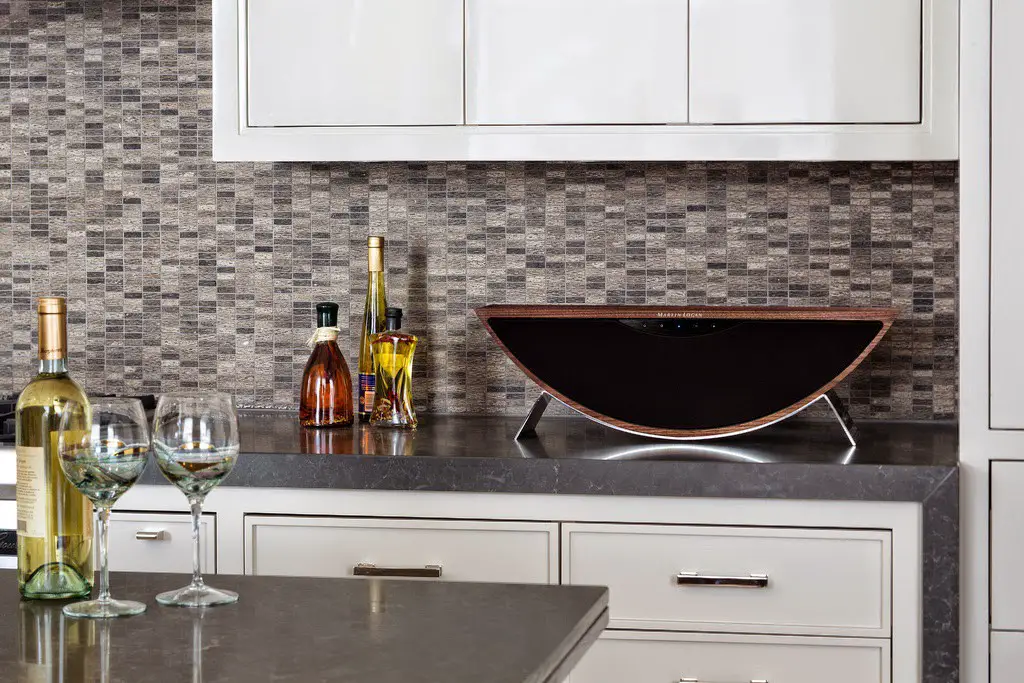 |
| The Crescendo is the most wife-friendly audiophile product I’ve ever seen and fits beautifully into any decor. |
Conclusion
The Crescendo sure is one superb performing, sexy audio system. You’ll be hard-pressed to get better performance in such a sleek-looking package. For those whose spouses have blocked the purchase of audiophile gear on aesthetic grounds, the MartinLogan Crescendo is your answer. Guys, listen up: this is the visually appealing, spouse-friendly, killer-sounding music system that you’ve been waiting for.
The Crescendo is solidly built for streaming and digital music. Setup is a breeze and it’s tightly integrated in with Apple’s ecosystem. It has input and integration options galore that you simply won’t find in other solutions. Add a wired or wireless subwoofer to the Crescendo and you have an unbelievable full range setup for music and home theater. In fact, when paired with a quality sub, like MartinLogan’s own Dynamo models, you’ll be hard-pressed to find any better sounding all-in-one system.
For me, the Crescendo would be a no-brainer top pick for best wireless music system. However, the hissing problem I uncovered is the only thing that gives me any pause. If and when MartinLogan addresses that issue, then the Crescendo goes to the top of my list. Either way, the Crescendo is a superb effort by MartinLogan and deserves an audition if you’re in the market for a wireless speaker system.
Specifications:
MartinLogan Crescendo
MSRP: $899.95
Inputs: 802.11b/g/n (2.4GHz) Bluetooth v4.0 (supports AAC, aptX®, MP3, SBC), USB (iPhone, iPad, iPod digital connection) Auxiliary analog/optical digital (3.5mm mini jack) RJ45 Ethernet
Weight: 15 lbs. (6.8kg)
Dimensions: (H x W x D) 8.1″ × 25.7″ × 6.9″ (20.53cm × 65.3cm × 17.5cm)


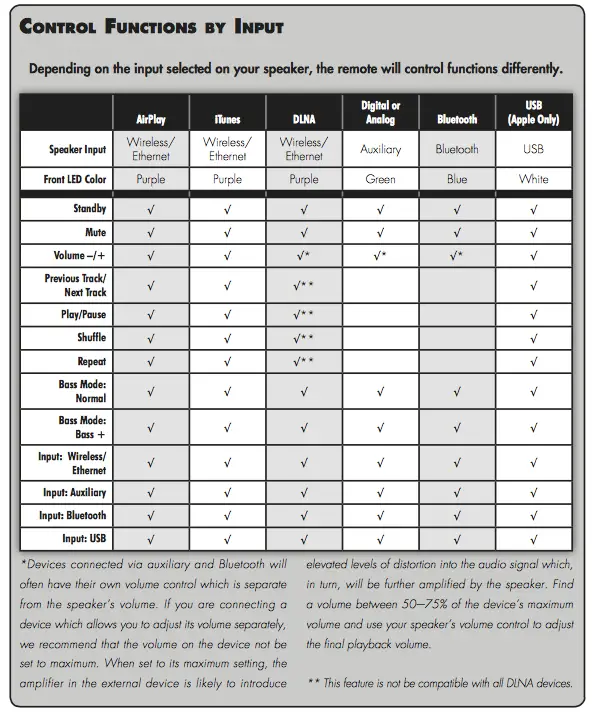














My Crescendo unit also had that hiss. After exchanging for a second device, that one too had that same hiss. After much back & forth with the support department, they conceded that there is a hiss and that I should exchage the Crescendo for something else (meaning: a different product).
This answer tell me their engineers are not keen on solving the problem. This is poor customer service and is not good for a company’s reputation.
I actually like the design and sound of the Crescendo, it’s on par with my B&W A7’s. I really would like to have the company fix this.
Comments are closed.